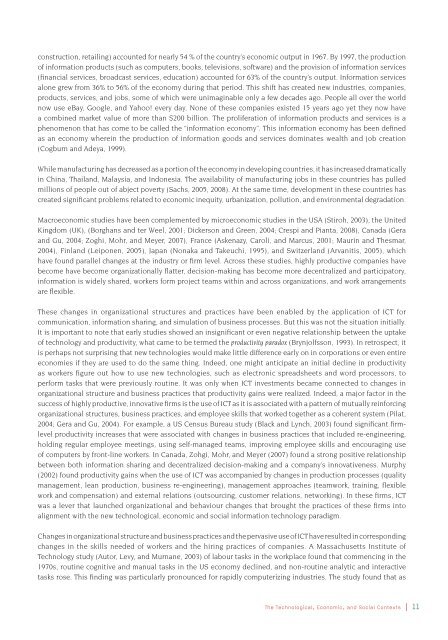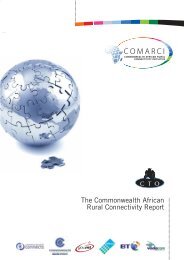Transforming education: the power of ICT policies - Commonwealth ...
Transforming education: the power of ICT policies - Commonwealth ...
Transforming education: the power of ICT policies - Commonwealth ...
You also want an ePaper? Increase the reach of your titles
YUMPU automatically turns print PDFs into web optimized ePapers that Google loves.
construction, retailing) accounted for nearly 54 % <strong>of</strong> <strong>the</strong> country’s economic output in 1967. By 1997, <strong>the</strong> production<br />
<strong>of</strong> information products (such as computers, books, televisions, s<strong>of</strong>tware) and <strong>the</strong> provision <strong>of</strong> information services<br />
(fi nancial services, broadcast services, <strong>education</strong>) accounted for 63% <strong>of</strong> <strong>the</strong> country’s output. Information services<br />
alone grew from 36% to 56% <strong>of</strong> <strong>the</strong> economy during that period. This shift has created new industries, companies,<br />
products, services, and jobs, some <strong>of</strong> which were unimaginable only a few decades ago. People all over <strong>the</strong> world<br />
now use eBay, Google, and Yahoo! every day. None <strong>of</strong> <strong>the</strong>se companies existed 15 years ago yet <strong>the</strong>y now have<br />
a combined market value <strong>of</strong> more than $200 billion. The proliferation <strong>of</strong> information products and services is a<br />
phenomenon that has come to be called <strong>the</strong> “information economy”. This information economy has been defi ned<br />
as an economy wherein <strong>the</strong> production <strong>of</strong> information goods and services dominates wealth and job creation<br />
(Cogburn and Adeya, 1999).<br />
While manufacturing has decreased as a portion <strong>of</strong> <strong>the</strong> economy in developing countries, it has increased dramatically<br />
in China, Thailand, Malaysia, and Indonesia. The availability <strong>of</strong> manufacturing jobs in <strong>the</strong>se countries has pulled<br />
millions <strong>of</strong> people out <strong>of</strong> abject poverty (Sachs, 2005, 2008). At <strong>the</strong> same time, development in <strong>the</strong>se countries has<br />
created signifi cant problems related to economic inequity, urbanization, pollution, and environmental degradation.<br />
Macroeconomic studies have been complemented by microeconomic studies in <strong>the</strong> USA (Stiroh, 2003), <strong>the</strong> United<br />
Kingdom (UK), (Borghans and ter Weel, 2001; Dickerson and Green, 2004; Crespi and Pianta, 2008), Canada (Gera<br />
and Gu, 2004; Zoghi, Mohr, and Meyer, 2007), France (Askenazy, Caroli, and Marcus, 2001; Maurin and Thesmar,<br />
2004), Finland (Leiponen, 2005), Japan (Nonaka and Takeuchi, 1995), and Switzerland (Arvanitis, 2005), which<br />
have found parallel changes at <strong>the</strong> industry or fi rm level. Across <strong>the</strong>se studies, highly productive companies have<br />
become have become organizationally fl atter, decision-making has become more decentralized and participatory,<br />
information is widely shared, workers form project teams within and across organizations, and work arrangements<br />
are fl exible.<br />
These changes in organizational structures and practices have been enabled by <strong>the</strong> application <strong>of</strong> <strong>ICT</strong> for<br />
communication, information sharing, and simulation <strong>of</strong> business processes. But this was not <strong>the</strong> situation initially.<br />
It is important to note that early studies showed an insignifi cant or even negative relationship between <strong>the</strong> uptake<br />
<strong>of</strong> technology and productivity, what came to be termed <strong>the</strong> productivity paradox (Brynjolfsson, 1993). In retrospect, it<br />
is perhaps not surprising that new technologies would make little difference early on in corporations or even entire<br />
economies if <strong>the</strong>y are used to do <strong>the</strong> same thing. Indeed, one might anticipate an initial decline in productivity<br />
as workers fi gure out how to use new technologies, such as electronic spreadsheets and word processors, to<br />
perform tasks that were previously routine. It was only when <strong>ICT</strong> investments became connected to changes in<br />
organizational structure and business practices that productivity gains were realized. Indeed, a major factor in <strong>the</strong><br />
success <strong>of</strong> highly productive, innovative fi rms is <strong>the</strong> use <strong>of</strong> <strong>ICT</strong> as it is associated with a pattern <strong>of</strong> mutually reinforcing<br />
organizational structures, business practices, and employee skills that worked toge<strong>the</strong>r as a coherent system (Pilat,<br />
2004; Gera and Gu, 2004). For example, a US Census Bureau study (Black and Lynch, 2003) found signifi cant fi rmlevel<br />
productivity increases that were associated with changes in business practices that included re-engineering,<br />
holding regular employee meetings, using self-managed teams, improving employee skills and encouraging use<br />
<strong>of</strong> computers by front-line workers. In Canada, Zohgi, Mohr, and Meyer (2007) found a strong positive relationship<br />
between both information sharing and decentralized decision-making and a company’s innovativeness. Murphy<br />
(2002) found productivity gains when <strong>the</strong> use <strong>of</strong> <strong>ICT</strong> was accompanied by changes in production processes (quality<br />
management, lean production, business re-engineering), management approaches (teamwork, training, fl exible<br />
work and compensation) and external relations (outsourcing, customer relations, networking). In <strong>the</strong>se fi rms, <strong>ICT</strong><br />
was a lever that launched organizational and behaviour changes that brought <strong>the</strong> practices <strong>of</strong> <strong>the</strong>se fi rms into<br />
alignment with <strong>the</strong> new technological, economic and social information technology paradigm.<br />
Changes in organizational structure and business practices and <strong>the</strong> pervasive use <strong>of</strong> <strong>ICT</strong> have resulted in corresponding<br />
changes in <strong>the</strong> skills needed <strong>of</strong> workers and <strong>the</strong> hiring practices <strong>of</strong> companies. A Massachusetts Institute <strong>of</strong><br />
Technology study (Autor, Levy, and Murnane, 2003) <strong>of</strong> labour tasks in <strong>the</strong> workplace found that commencing in <strong>the</strong><br />
1970s, routine cognitive and manual tasks in <strong>the</strong> US economy declined, and non-routine analytic and interactive<br />
tasks rose. This fi nding was particularly pronounced for rapidly computerizing industries. The study found that as<br />
The Technological, Economic, and Social Contexts | 11
















